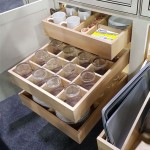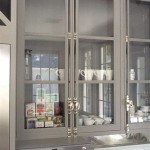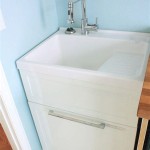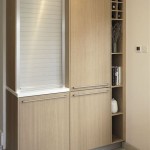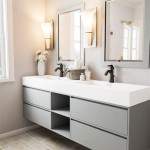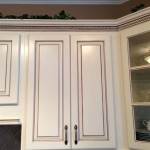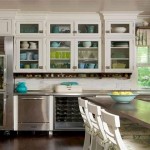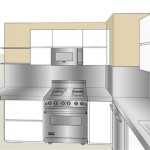What Are The Parts Of A Kitchen Cabinet Called?
Understanding the anatomy of a kitchen cabinet is beneficial for various reasons, from planning a remodel to performing repairs and appreciating the craftsmanship involved. Kitchen cabinets, seemingly simple boxes, are composed of numerous individual parts. Each part contributes to the overall structural integrity, functionality, and aesthetic appeal of the cabinet unit. Knowing the names and functions of these parts allows for more informed decision-making during design, purchase, installation, and maintenance.
Kitchen cabinets are typically categorized into two main types: base cabinets and wall cabinets. Base cabinets sit on the floor and provide a foundation for countertops. Wall cabinets are mounted on the wall and offer storage above counters and appliances. While their dimensions and specific features may differ, both types of cabinets share a core set of component parts. This article will delve into these components, providing detailed information about their names, functions, and variations.
Cabinet Box Components
The cabinet box forms the structural core of the cabinet. It is the basic enclosure that houses the shelves, drawers, and other internal elements. The box is primarily constructed from sheet materials, typically plywood, particleboard, or medium-density fiberboard (MDF). The quality and thickness of these materials greatly influence the cabinet's durability and stability.
Sides (End Panels): The sides, also known as end panels, are the vertical boards that form the left and right sides of the cabinet box. They provide structural support and define the cabinet's width. In exposed-end cabinets, the sides are often finished with a decorative veneer or paint to match the cabinet doors and drawer fronts. The thickness of the sides is a crucial factor in determining the cabinet's overall strength, with thicker sides generally offering greater load-bearing capacity.
Top and Bottom Panels: The top and bottom panels form the horizontal surfaces of the cabinet box. The bottom panel supports the weight of the contents placed inside the cabinet. In base cabinets, the bottom panel rests on the cabinet's base or legs. The top panel, in wall cabinets, provides a surface for attaching the cabinet to the wall. In base cabinets, the top panel is often a stretcher rail, offering structural support without providing a full surface, allowing for easier access to plumbing or electrical wiring. The construction of these panels is vital for maintaining the squareness and rigidity of the cabinet box.
Back Panel: The back panel is the rear-facing board of the cabinet box. It is typically made of thinner material than the sides, top, and bottom. The back panel provides stability to the cabinet box and helps to keep it square. It also provides a surface for mounting the cabinet to the wall (in the case of wall cabinets). The method by which the back panel is attached to the cabinet sides (e.g., stapled, glued, or dadoed) significantly impacts the cabinet's overall strength and resistance to racking.
Face Frame (Optional): A face frame is a frame of solid wood attached to the front of the cabinet box. It consists of horizontal rails (top and bottom) and vertical stiles (left and right). Face frames provide additional structural support and a surface for attaching doors and drawer fronts. Cabinets with face frames are generally considered more traditional in style. Frameless cabinets, also known as European-style cabinets, do not have a face frame, allowing for full access to the cabinet interior and a more contemporary look. The joinery used to construct the face frame (e.g., mortise and tenon, dowel joints) is critical for its strength and longevity.
Stretcher Rails: Stretcher rails are horizontal pieces of wood that run along the top and back of the cabinet, typically in base cabinets or frameless cabinets. They add structural support and prevent the cabinet from racking or twisting. They also provide a surface for attaching the countertop. In frameless cabinets, the top stretcher rail often serves as the primary attachment point for the countertop.
Internal Components
The internal components of a kitchen cabinet determine its functionality and storage capacity. These include shelves, drawers, and any specialized hardware or accessories.
Shelves: Shelves are horizontal surfaces inside the cabinet that provide storage space for dishes, cookware, and other items. They can be fixed or adjustable. Fixed shelves are permanently attached to the cabinet sides, while adjustable shelves can be moved up or down to accommodate items of different sizes. Adjustable shelves are typically supported by shelf pins or clips inserted into pre-drilled holes in the cabinet sides. The construction of the shelves (e.g., solid wood, plywood, particleboard) and their thickness determine their weight-bearing capacity.
Drawers: Drawers are sliding containers that provide accessible storage for utensils, cookware, and other items. They consist of a drawer box, drawer front, and drawer slides. The drawer box is the basic container that holds the contents. The drawer front is the decorative panel attached to the front of the drawer box. Drawer slides allow the drawer to open and close smoothly. The quality of the drawer slides greatly impacts the drawer's functionality and durability. Drawer slides can be side-mounted, undermounted, or center-mounted, each offering different load capacities and extension capabilities.
Drawer Box: The drawer box is typically constructed from plywood, solid wood, or a composite material. The joints that connect the sides, front, and back of the drawer box (e.g., dovetail joints, dado joints) influence its strength and stability. The bottom of the drawer box is usually made of plywood or hardboard and is attached to the sides, front, and back. It is important that the bottom is securely attached to prevent sagging or failure under load.
Drawer Front: The drawer front is the visible part of the drawer and is usually made from wood, MDF, or a combination of materials. It is designed to match the cabinet doors and other decorative elements of the kitchen. The drawer front is attached to the drawer box using screws or other fasteners. The style and finish of the drawer front contribute significantly to the overall aesthetic of the kitchen.
Drawer Slides: Drawer slides are mechanical devices that allow drawers to open and close smoothly and quietly. They come in various types, including ball-bearing slides, roller slides, and soft-close slides. Ball-bearing slides are generally considered the most durable and offer the smoothest operation. Soft-close slides prevent the drawer from slamming shut, reducing noise and wear and tear. The weight capacity of the drawer slides should be appropriate for the intended use of the drawer.
Roll-Out Trays: Roll-out trays, also known as pull-out shelves, are similar to drawers but are typically used behind cabinet doors. They provide easy access to items stored in the back of the cabinet. Roll-out trays are mounted on drawer slides and can be pulled out to reveal the contents. They are particularly useful for storing pots, pans, and other bulky items.
Lazy Susans: Lazy Susans are rotating shelves often installed in corner cabinets. They allow for easy access to items stored in the back of the cabinet, maximizing storage space in otherwise difficult-to-reach areas. Lazy Susans can be full-circle or pie-cut, depending on the shape of the corner cabinet.
External Components and Hardware
The external components and hardware of a kitchen cabinet contribute to its aesthetic appeal and functionality. These include doors, drawer fronts, hinges, knobs, pulls, and decorative trims.
Doors: Doors are hinged panels that cover the cabinet opening. They can be constructed from various materials, including wood, MDF, and laminate. Door styles vary widely, from simple flat panels to ornate raised-panel designs. The door style significantly impacts the overall look and feel of the kitchen.
Door Styles: Common door styles include shaker, raised panel, flat panel (slab), and glass-front doors. Shaker doors feature a flat center panel surrounded by a simple frame. Raised panel doors have a raised center panel that adds depth and dimension. Flat panel doors are simple and modern, with a flat surface. Glass-front doors allow for displaying dishes or other items inside the cabinet. The selection of door style should complement the overall design aesthetic of the kitchen.
Hinges: Hinges are the hardware that connects the doors to the cabinet box, allowing them to open and close. They come in various types, including concealed hinges, surface-mounted hinges, and self-closing hinges. Concealed hinges are hidden from view when the door is closed, providing a clean, seamless look. Surface-mounted hinges are visible when the door is closed and can add a decorative element. Self-closing hinges automatically pull the door shut when it is close to the cabinet. The quality of the hinges is crucial for the smooth and reliable operation of the doors.
Knobs and Pulls: Knobs and pulls are decorative hardware attached to the doors and drawers, used for opening and closing them. They come in a wide variety of styles, materials, and finishes. The selection of knobs and pulls should complement the style of the cabinets and the overall design of the kitchen.
Decorative Trim: Decorative trim includes moldings, valances, and other decorative elements that are added to the cabinets to enhance their aesthetic appeal. Moldings can be used to create a more finished look around the edges of the cabinets. Valances are decorative panels that are installed above the sink or other areas. The addition of decorative trim can significantly enhance the visual appeal of the kitchen cabinets.
Toe Kick: The toe kick is the recessed space at the bottom of base cabinets that allows you to stand comfortably at the counter without bumping your toes. It is typically covered with a thin panel of material that matches the cabinet finish. The toe kick provides a functional and aesthetic benefit.
Understanding the various parts of a kitchen cabinet enhances one's ability to communicate effectively with designers, contractors, and manufacturers, aiding in the planning, installation, and maintenance of kitchen cabinetry. It also allows for a deeper appreciation of the construction and design principles involved in creating functional and aesthetically pleasing kitchen spaces.

Cabinet Parts And Profiles

Parts Of A Cabinet Doors

Kitchen Cabinet Parts Terminology Granite Quartz Countertops Cabinets Factory
Kitchen Cabinets 1 Rona

Kitchen Cabinet Parts Terminology Granite Quartz Countertops Cabinets Factory

How To Choose Kitchen Cabinets When Remodeling

Anatomy Of A Cabinet Door Crystal Cabinets

Kitchen Definitions The Classics

Kitchen Definitions The Classics

Parts Of A Cabinet Doors
Related Posts

